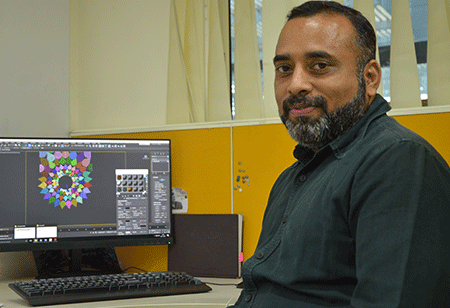
In conversation with Charulatha, Correspondent, Homes India Magazine, Aiyappa discusses the importance of incorporating technology into the strategy for customizing and supervising the interior design creation process. Furthermore, he highlights the specific software and tools that hold particular value in this context.
Aiyappa Alemada journey has taken him from understanding raw materials to crafting furniture. Over time, he has developed businesses in the furniture and interior space, focusing on quality and customer trust. He has 25 years of professional experience in the sector. At Purva Streaks, he ensures a seamless and exceptional experience for all their customers.
How to Promote Collaboration with Production Teams for Custom Interior Designs?
By establishing an in-house design team within your organization to collaborate closely with your valued customers. The key is to focus on creating products that are not only innovative but also easy to manufacture within your own facilities. This means handling the entire process, from designing to production and delivery, all under one roof. This approach offers your customers a unique opportunity to become part of the product development journey, ensuring transparency and involvement throughout. A clear vision with a commitment to meeting the specific needs of each customer is imperative for a well-designed and efficiently produced product.
The Significance of Technology in Customizing and Overseeing Interior Design: Key Software and Tools.
Artificial Intelligence (AI) plays a crucial role in customizing integrated design and manufacturing processes, particularly in the realm of customer interaction. Many companies and startups are recognizing the potential of AI to transform the way businesses operate and interact with customers. In our experience, AI is poised to make a significant impact, and we've been approached by numerous startups offering AI solutions to enhance our operations.
As a company engaged in manufacturing for nearly a year, we see the value in adopting AI technologies to streamline and enhance our processes. AI can facilitate more efficient design customization and, importantly, improve the customer experience. This shift towards AI integration is not only beneficial but also an inevitable evolution in the industry.
Startups are at the forefront of developing innovative AI solutions that can greatly benefit businesses. We believe that embracing AI technology is essential for scaling up operations and staying competitive in the ever-evolving landscape of design and manufacturing. It's a promising avenue to explore, and we anticipate that AI will continue to play a pivotal role in the future of our industry.
"Artificial Intelligence (AI) plays a crucial role in customizing integrated design and manufacturing processes, particularly in the realm of customer interaction."
How 3D Printing Transforms Custom Furniture and Decor in Interior Design.
Using 3D technology in interior design allows for the creation of custom furniture and decor pieces, enhancing the customer experience. While 3D serves as a visual representation, 2D remains a fundamental technique for customization. When customization is needed, a 2D technical drawing is essential for production. 3D plays a vital role as a customer interface, bridging the gap between technical knowledge and customer understanding. It enables customers to grasp how their furniture will appear, even if they aren't familiar with technical drawings. In fact, it can provide customers with a clear picture of their project, covering about 85-90% of the overall understanding.
Guiding Home Buyers with Limited Design Knowledge Towards a Coherent Design Concept.
The quality of our design team plays a pivotal role in the home-buying process. Their knowledge, training, and access to various tools and experiences are essential for customers to grasp the final outcome. When customers visit our facilities or explore our modern apartments, they can interact with physical samples, providing a tangible understanding of what they can expect. Our extensive catalogs, sample collections, and fully functional furniture displays offer numerous touchpoints for decision-making. This collaborative effort between the design and technical teams ensures that customers have a clear vision of their choices, making the home-buying journey more informed and straightforward.
"3D plays a vital role as a customer interface, bridging the gap between technical knowledge and customer understanding."
Balancing Customization and Production Efficiency in Backward-Integrated Interior Design Firms
In our line of business, technology plays a crucial role in achieving scalability and realizing our vision. Custom manufacturing is our focus, and technology empowers us to produce customized products on a larger scale. While our past approach was more traditional, we are now able to efficiently handle up to 160 custom projects per month. Technology is indispensable in this transformation, allowing us to meet our goals effectively.
Adapting Interior Design through Backward Integration for Lifestyle-Specific Preferences.
Backward integration is a critical aspect of our approach. As designers, we have the ability to create beautiful concepts. However, without this integration, our designs can remain mere ideas on paper. The power of backward integration lies in its two-way connection. What we conceive, we can directly bring to life, eliminating any disparity between our vision and reality. By embracing new technologies or methods, we adapt and seamlessly transfer these advancements into large-scale production. Backward integration has been my guiding principle since the beginning of my career. It ensures that our thought process aligns seamlessly with our product delivery. By minimizing reliance on external factors, we gain control over our commitments to customers. This approach empowers our interior designers, enhancing their ability to confidently meet customer expectations, going beyond their design expertise.
Conclusion: Not everyone may embrace the concept of a backward integrated model, but for those truly dedicated to building a robust business portfolio centered on customer commitment, innovation, and enhanced experiences through technology implementation, this approach represents a promising path for industry growth.
We use cookies to ensure you get the best experience on our website. Read more...
Copyright © 2025 HomesIndiaMagazine. All Rights Reserved.